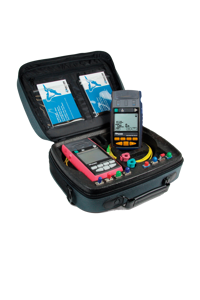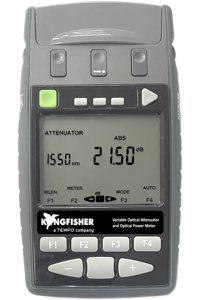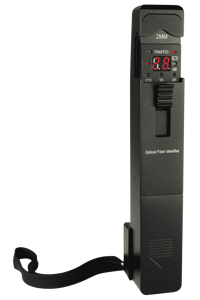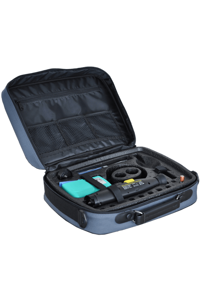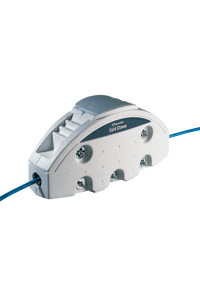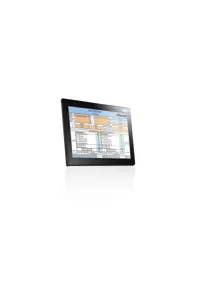Introduction
This instruction describes the procedure for determining the modal launch condition and category of a light source or fiber end by measuring its coupled power ratio (CPR).
Scope
This instruction is applicable for all multimode light sources with particular emphasis on LED sources.
This instruction has been written around 50 µm fiber core CPR measurement. For measuring CPR of 62.5 µm systems, substitute 62.5 µm MM patch leads and lookup table data as appropriate.
Apparatus required:
- Power meter with InGaAs / Germanium detector, or Silicon detector if only working at 850 nm.
- 50 μm patch lead, 1-5 meters long.
- Single mode patch lead, standard type for 1300 nm, 1-5 meters long, configured with one 30 mm diameter loop.
- Single mode patch lead, special type for 850 nm, 1-5 meters long, configured with one 30 mm diameter loop.
- Through connects to suit instruments and patch-leads.
Note: Connectors on the above patch leads shall have losses <= 0.5 dB (@ 850 & 1300 nm).
Note: Connectors with PC finish are best as they inhibit Fresnel reflections.
Steps
- Check that all patch-leads and connectors are clean.
- First measurement (MM)
Connect a 50 μm MM patch-lead between the light source and a power meter as in Figure 1, and zero the meter.
Note: Keep the patch-lead as straight as possible (avoid bends of less than 50 mm diameter) as could affect the modal power distribution and hence the measurement accuracy).
- Final measurement (SM)
Leave the MM lead connected to the light source and connect the correct SM patch-lead. Make a 30 mm diameter loop, which acts as a mode filter.
Measure & record the power output (L2) of the MM to SM pigtail combination.
- CPR coefficient calculation
As meter was zeroed the CPR = - L2 (dB)
Otherwise the CPR coefficient is calculated as:
CPR = L1 – L2 (dB)
- Round to the nearest 0.1 dB
- Mechanical instability
Should mechanical instability cause variations >0.5 dB. The standards specify repeating the measurement 5 times and averaging the results.
- CPR category
Use the look up table below to determine the CPR Category of the light source.
| Table 1 – 850 nm CPR Categories |
| Fibre Size |
Category 1
Overfilled |
Category 2 |
Category 3 |
Category 4 |
Category 5
Greatly under filled |
| 50 μm |
20-24 |
16-19.9 |
11-15.9 |
6-10.9 |
0-5.9 |
| 62.5 μm |
25-29 |
21-24.9 |
14-20.9 |
7-13.9 |
0-6.9> |
| 100/140 μm |
30-34 |
26-29.9 |
18-25.9 |
10-17.9 |
0-9.9 |
| Table 2 – 1300 nm CPR Categories |
| Fibre Size |
Category 1
Overfilled |
Category 2 |
Category 3 |
Category 4 |
Category 5
Greatly under filled |
| 50 μm |
16-20 |
12-15.9 |
8-11.9 |
4-7.9 |
0-3.9 |
| 62.5 μm |
21-25 |
17-20.9 |
12-16.9 |
7-11.9 |
0-6.9 |
| 100/140 μm |
26-30 |
22-25.9 |
15-21.9 |
8-14.9 |
0-7.9 |
References
TIA/EIA 526-14A OFSTP-14, Optical Power Loss Measurements of Installed Multimode Fiber Cable Plant IEC 61280-4-1 Fibre-Optic Communication Subsystem Basic Test Procedures – Part 4-1: Test procedures for fibre-optic cable plant links – Multimode fibre-optic cable plant attenuation measurement.
IEC 61300-3-31 Fibre optic interconnecting devices and passive components – Basic T&M procedures – Part 3-31: Examinations and measurements – Coupled power ratio measurement for fibre optic sources.
Note:
At time of writing, it is understood that the standard bodies ISO/IEC, IEC and CLC are seeking a method to create a multimode, mode conditioning patch cord which can be used to create a light source with a defined launch condition. ‘Launch’ date is scheduled for September 2004.


